Electronic Nicotine Delivery Systems (ENDS)
ENDS Use in Wyoming
ENDS Usage
 ENDS are electronic nicotine delivery systems, also known as e-cigarettes or vapes. When people use ENDS, they are vaping. In 2018, the Surgeon General officially called youth and young adult vaping an epidemic (USDHHS, 2018). Studies show that young adults who have never smoked start using nicotine products by using ENDS (Bandi et al., 2020). They are then more likely to begin smoking combustible cigarettes (Berry et al., 2019; Hair et al., 2021).
ENDS are electronic nicotine delivery systems, also known as e-cigarettes or vapes. When people use ENDS, they are vaping. In 2018, the Surgeon General officially called youth and young adult vaping an epidemic (USDHHS, 2018). Studies show that young adults who have never smoked start using nicotine products by using ENDS (Bandi et al., 2020). They are then more likely to begin smoking combustible cigarettes (Berry et al., 2019; Hair et al., 2021).
Although ENDS use is less common among adults than smoking cigarettes or chewing tobacco, their recent emergence on the market and surging use among youth and young adults make them a key tobacco prevention issue.
Most Wyoming adults (72%) have never tried ENDS and few are current ENDS users (Figure 1). For this report, current ENDS users are the respondents who said they use ENDS every day or some days.
ENDS use was about as common in 2019 as it was in 2015, the first time this question was asked on the ATS (Figure 2).

Flavored ENDS Use
The Wyoming 2019 ATS was completed before new FDA flavor restrictions went into effect. In 2020, the FDA banned ENDS flavors except menthol and tobacco. However, the ban has large loopholes. It only applies to the cartridge ENDS style, like JUUL. These products have closed, pre-filled e-liquid cartridges that the user replaces when empty. The ban does not include ENDS with refillable e-liquid tanks or single-use or disposable products, like Puff Bar. According to the FDA, these exceptions avoided restricting all ENDS flavor options for adults who may be using e-cigarettes to stop smoking (FDA, 2020). However, data from Truth Initiative’s vaping cessation program, This is Quitting, showed that many youth and young adult ENDS users enrolled in the program were switching to the types of ENDS that can still have flavors (Truth Initiative, 2020).
In 2019, the use of flavored ENDS was common for Wyoming adults:
- 83% of current ENDS users had used products flavored to taste like menthol, alcohol, candy, fruit, chocolate, or other sweets in the past 30 days.
- 45% of adults who had ever tried ENDS in their lifetime did so for reasons related to flavor.
Because the use of flavored ENDS is common among Wyoming adult ENDS users, it will be important to monitor how the use of ENDS among Wyoming adults changes in response to the FDA ban.
Preferred ENDS Types
Most adult ENDS users (82%) preferred a customized commercial juice or liquid from a vape shop to prefilled cartridges or mixing their own e-liquid. The FDA’s 2020 flavor ban did not cover this type of ENDS.
The 2019 ATS questionnaire added Juul as a brand option. It was by far the most preferred cartridge-style ENDS brand; 22% of ENDS users reported using Juul most often in the previous 30 days. The next most often used brand was Blu at 9% of users.
Reason for Trying ENDS
 The top three reasons for trying ENDS were curiosity (60%), cutting back on smoking without necessarily trying to quit (55%), and to quit smoking cigarettes (54%; Figure 3). These results have not changed significantly since these questions were first asked in 2015. The U.S. Food and Drug Administration (FDA) has not approved ENDS as a cessation aid (FDA, 2019).
The top three reasons for trying ENDS were curiosity (60%), cutting back on smoking without necessarily trying to quit (55%), and to quit smoking cigarettes (54%; Figure 3). These results have not changed significantly since these questions were first asked in 2015. The U.S. Food and Drug Administration (FDA) has not approved ENDS as a cessation aid (FDA, 2019).
Do People Think ENDS Use Is Harmful?
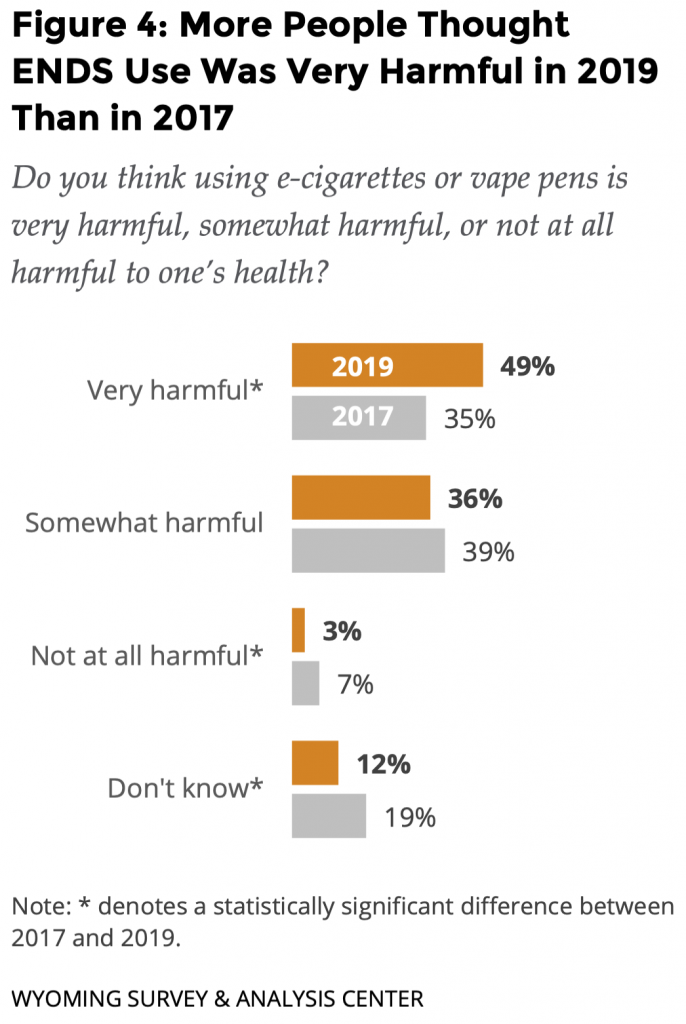 The 2019 ATS included a series of questions regarding how harmful people think ENDS use is. In 2019, more people thought ENDS use was very harmful than in 2017 (Figure 4).
The 2019 ATS included a series of questions regarding how harmful people think ENDS use is. In 2019, more people thought ENDS use was very harmful than in 2017 (Figure 4).
There are two likely reasons for this change. First, the public health community, including the TPCP, sponsored media messaging about the harms of ENDS use after 2017.
Second, an outbreak of lung injury associated with vaping was occurring as some people were answering the ATS questions. The early news headlines and public health communication about the outbreak may have influenced respondents’ answers to these items. Data has since shown the majority of cases in the outbreak were linked to THC or marijuana-containing products (CDC, 2020b).
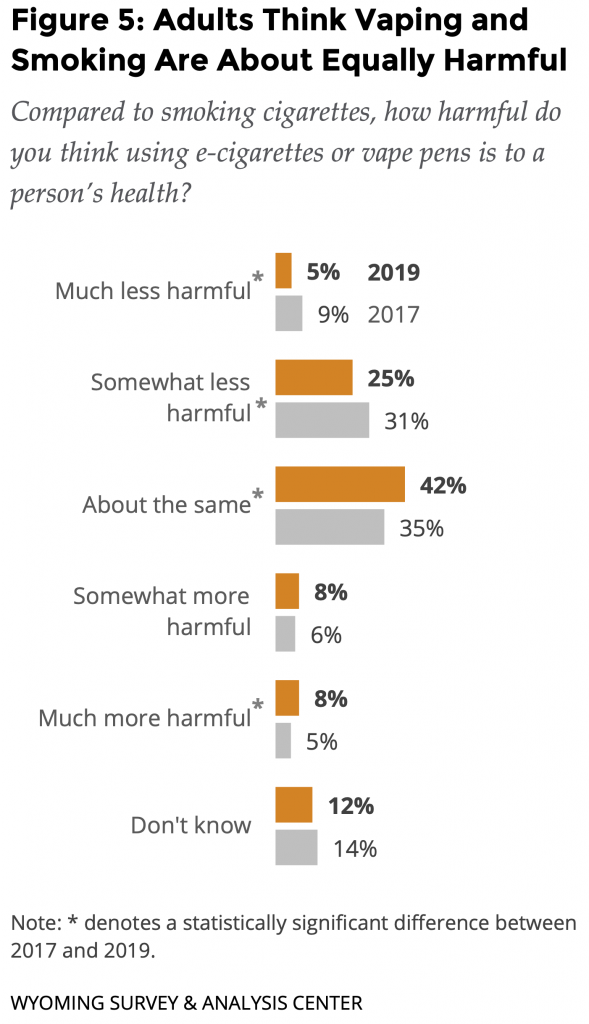 Three detailed findings stand out from the 2019 data. All relate to adults feeling more informed about the harms of vaping: (a) fewer adults said they did not know how harmful vaping was, (b) fewer adults think vaping is not at all harmful, and (c) more adults say that vaping is very harmful.
Three detailed findings stand out from the 2019 data. All relate to adults feeling more informed about the harms of vaping: (a) fewer adults said they did not know how harmful vaping was, (b) fewer adults think vaping is not at all harmful, and (c) more adults say that vaping is very harmful.
In 2019, compared to 2017, more adults said that vaping was about as harmful as, or even much more harmful than, smoking (Figure 5).
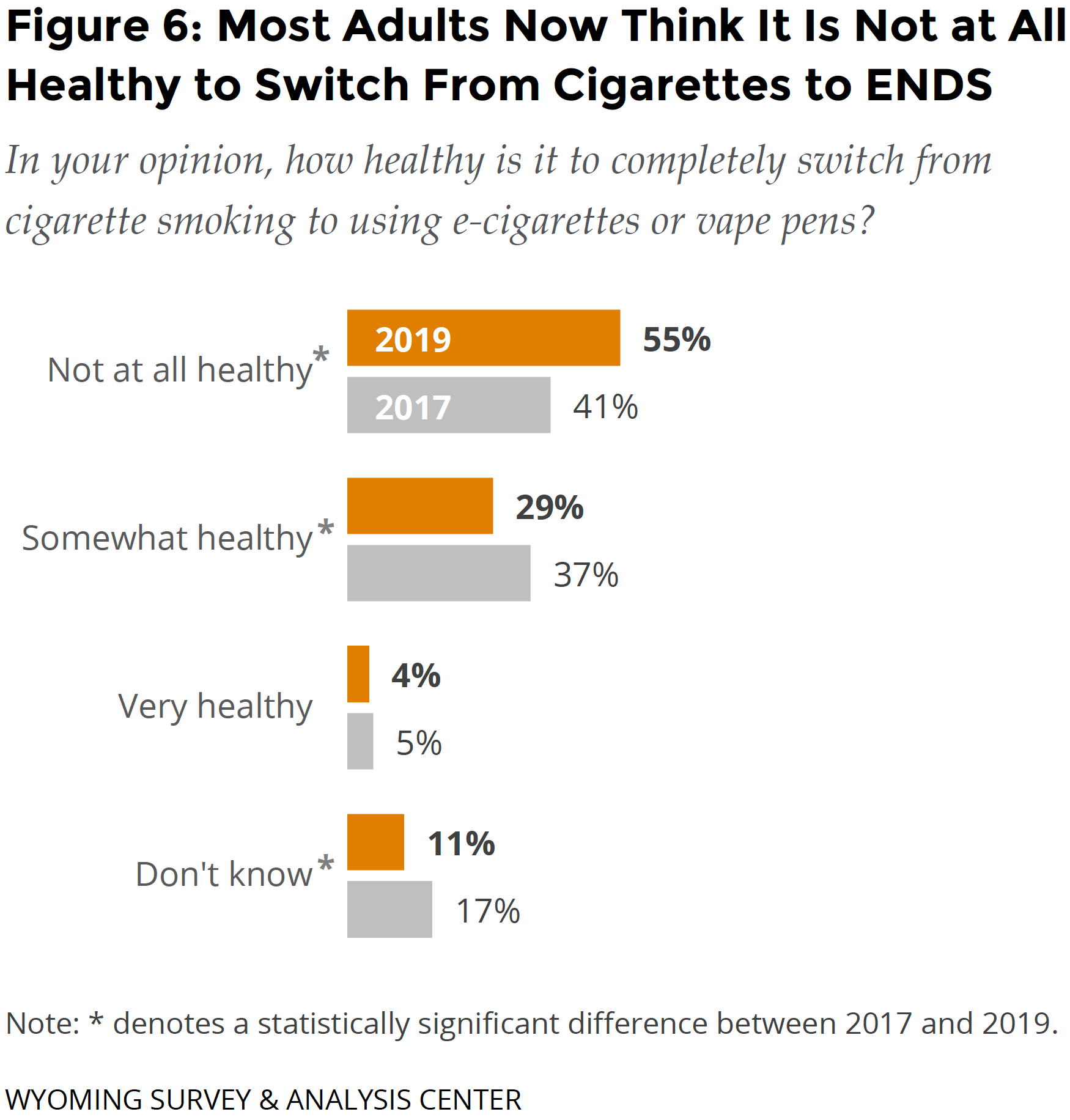
Most adults (55%) now believe that switching from cigarette smoking to using ENDS is not at all healthy, a significant increase since 2017 (41%; Figure 6). Those who said that switching is somewhat healthy decreased from 37% in 2017 to 29% in 2019. However, the number of people who said that making the switch was very healthy stayed about the same (4% vs 5% in 2017). Adults were less likely to report they did not know if making the switch was healthy or not (11% vs 17%). This change is part of a pattern in the data that suggests adults were more informed about the harms of vaping than in 2017.
While more research is needed, the CDC has stated that smokers may see benefits from a complete switchover, with the caution that smokers are actually more likely to add a vaping habit to their smoking rather than completely switch (CDC, 2020a).
Initiation of ENDS Use
 Current, former, and experimental smokers (see Table 1 below for a summary of the four smoking status categories) who had also tried ENDS were asked whether they used cigarettes or ENDS first. For most of these smokers (64%), this question was not applicable because ENDS were not on the market (to their knowledge) when they started smoking. However, more of the remaining smokers reported using ENDS before cigarettes in 2019 than in 2017 (Figure 7). Younger people turning 18 and becoming eligible for the ATS may be contributing to this change. Although a different research approach would provide stronger evidence, the 2019 ATS data support emerging research (such as Berry et al., 2019; Hair et al., 2021) that vaping may lead people to smoke, including some people who would not otherwise have started smoking.
Current, former, and experimental smokers (see Table 1 below for a summary of the four smoking status categories) who had also tried ENDS were asked whether they used cigarettes or ENDS first. For most of these smokers (64%), this question was not applicable because ENDS were not on the market (to their knowledge) when they started smoking. However, more of the remaining smokers reported using ENDS before cigarettes in 2019 than in 2017 (Figure 7). Younger people turning 18 and becoming eligible for the ATS may be contributing to this change. Although a different research approach would provide stronger evidence, the 2019 ATS data support emerging research (such as Berry et al., 2019; Hair et al., 2021) that vaping may lead people to smoke, including some people who would not otherwise have started smoking.

Promoting Cessation
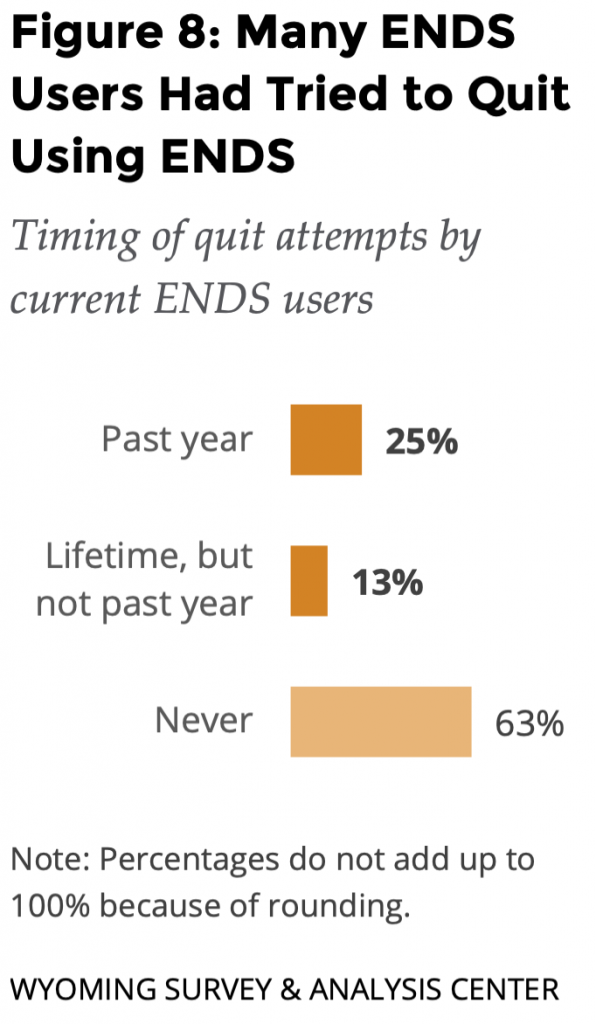 As noted above, 21% of adults had tried ENDS but were not current users. This group could include former regular users and people who experimented with ENDS but never became regular users. The 2019 ATS questions do not allow a breakdown of those groups.
As noted above, 21% of adults had tried ENDS but were not current users. This group could include former regular users and people who experimented with ENDS but never became regular users. The 2019 ATS questions do not allow a breakdown of those groups.
Although ENDS are a relatively new type of tobacco product, many current ENDS users have already tried to quit using them for good. At some point in their lives, about one third of current ENDS users (38% overall) had stopped using ENDS for at least one day because they were trying to quit for good (Figure 8).
Many Wyoming smokers vape as part of their strategy to quit smoking (Figure 3). According to the CDC, current research regarding ENDS use and quitting smoking is uncertain. There is some evidence suggesting that increased use of ENDS containing nicotine is associated with an increase in smoking cessation when compared to ENDS with no nicotine. However, there is not enough evidence to make any definitive claims (CDC, 2020c). In Wyoming, 72% of regular smokers (current and former; see Table 1) who had tried ENDS reported quitting smoking as one of their reasons for trying them.
ENDS-Related Disparities
Generations-long inequities in social, economic, and environmental conditions contribute to adverse health outcomes. Breakdowns by race, ethnicity, or socioeconomic status may reflect where a person lives, works, or plays rather than the individual’s characteristics or personal choices. These inequities have a greater impact on health outcomes than individual choices.
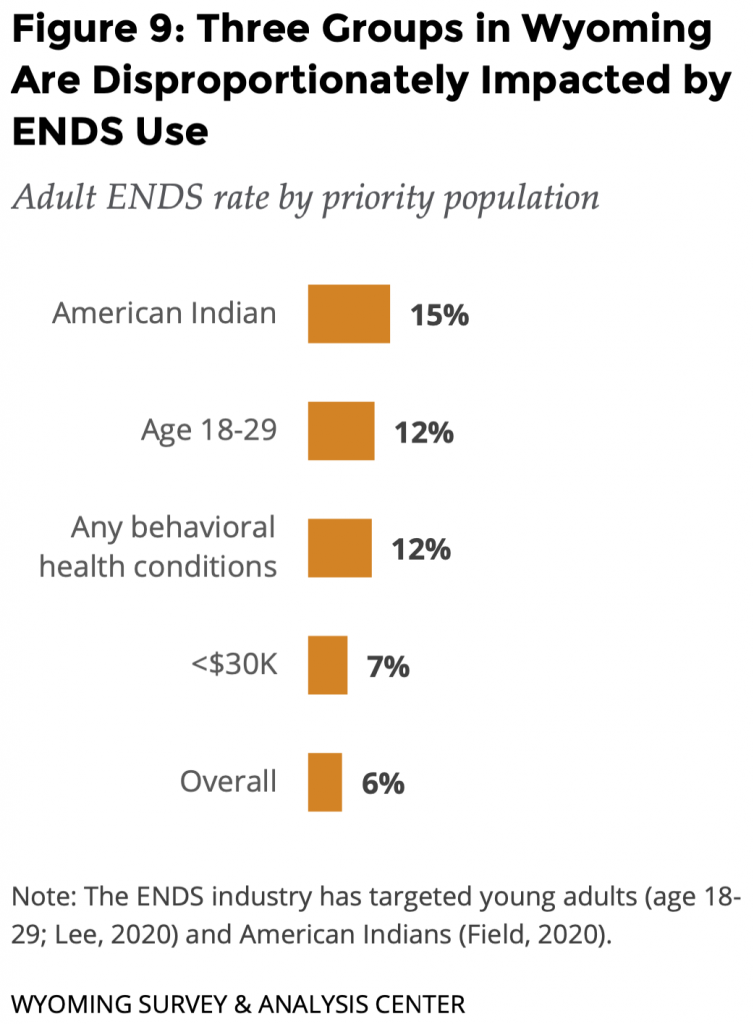 The TPCP has identified four priority populations, primarily based on disparities in the use and burden of traditional tobacco products: people with low incomes, American Indians, people experiencing behavioral health conditions, and young adults (18-29). As the ENDS market develops, WYSAC and the TPCP are monitoring ENDS use to identify and eliminate disparities of ENDS use among the selected priority populations (Figure 9).
The TPCP has identified four priority populations, primarily based on disparities in the use and burden of traditional tobacco products: people with low incomes, American Indians, people experiencing behavioral health conditions, and young adults (18-29). As the ENDS market develops, WYSAC and the TPCP are monitoring ENDS use to identify and eliminate disparities of ENDS use among the selected priority populations (Figure 9).
Three groups in Wyoming are disproportionately impacted by ENDS use: American Indians, young adults, and adults who reported having behavioral health conditions. This may be because the ENDS industry has focused marketing toward young adults (Lee, 2020) and American Indians (Field, 2020). WYSAC’s literature review did not find conclusive evidence that the ENDS industry is also using targeted marketing toward people experiencing behavioral health conditions and lower incomes. In Wyoming, income does not appear related to adults’ ENDS use.
The 2019 ATS included follow-up questions about quitting ENDS use. Fewer than 50 ENDS users within each priority population answered those questions. That is insufficient data for a precise estimate of lifetime and past year quit attempts in this report. WYSAC is available to discuss the data and associated limitations with interested parties.
American Indian
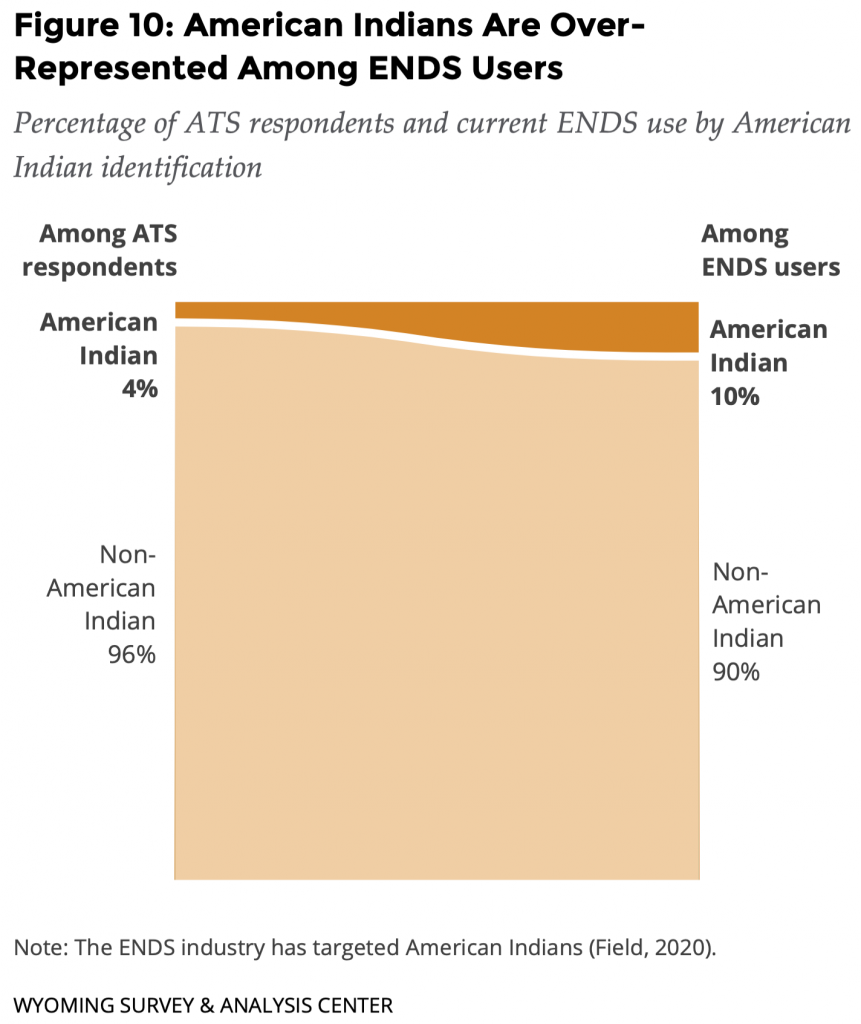 We acknowledge that different terms refer to the Indigenous population of the U.S. when unable to refer to specific tribes. In this report, use of the term American Indian mirrors the CDC-suggested survey item used for the ATS.
We acknowledge that different terms refer to the Indigenous population of the U.S. when unable to refer to specific tribes. In this report, use of the term American Indian mirrors the CDC-suggested survey item used for the ATS.
Respondents were considered American Indian when they self-identified as American Indian or multiracial including American Indian, regardless of whether they reported Hispanic ethnicity. This approach allowed for a larger sample from which to draw conclusions.
Focused efforts from tobacco companies have contributed to high smoking rates for American Indians (D’Silva et al., 2018). There is evidence that the ENDS industry is using this focused marketing of their products toward American Indians. A congressional investigation found ENDS manufacturer Juul targeted American Indian tribes with price discounts and programs (Field, 2020; Subcommittee on Economic and Consumer Policy, 2020). In Wyoming, ENDS use is more than double for American Indians (15%) than the overall population.
American Indians are over-represented among ENDS users (Figure 10). Only 4% of adults who responded to the survey identified as American Indian (including people who were multiracial including American Indian), yet they made up 10% of ENDS users in the survey.
Young Adults
 Respondents were considered young adults when they were between ages 18 and 29 years.
Respondents were considered young adults when they were between ages 18 and 29 years.
Much like the tobacco industry has targeted youth in the past (Farber & Folan, 2017), the ENDS industry has targeted young adults with advertising and marketing (Lee, 2020). The ENDS industry uses social media as a pathway to reach young adults (Lee, 2020).
With the ENDS industry’s focused marketing, ENDS use is more than double for young adults (ages 18 to 29; 12%), compared to older adults (ages 30 and older; 5%).
Young adults are over-represented among ENDS users. Only 22% of adults who responded to the survey were young adults, yet they made up 42% of current ENDS users in the survey (Figure 11).
Behavioral Health
 Historically, the tobacco industry has targeted people experiencing behavioral health conditions (such as depressive disorder, bipolar disorder, substance use disorder, and psychotic disorder; Williams et al., 2013). More research is needed to understand if the ENDS industry is also using focused marketing toward people experiencing behavioral health conditions.
Historically, the tobacco industry has targeted people experiencing behavioral health conditions (such as depressive disorder, bipolar disorder, substance use disorder, and psychotic disorder; Williams et al., 2013). More research is needed to understand if the ENDS industry is also using focused marketing toward people experiencing behavioral health conditions.
For the ATS, respondents were considered to have a behavioral health condition if they reported one or more of the following conditions: anxiety disorder, depression disorder, bipolar disorder, alcohol abuse, drug abuse, or schizophrenia.
ENDS use is more than double for adults experiencing behavioral health conditions (12%), compared to those experiencing no behavioral conditions (5%).
Adults with behavioral health conditions are over-represented among ENDS users (Figure 12). Although 18% of adults who responded to the survey had behavioral health conditions, they made up 34% of ENDS users in the survey.
As with any self-report data, it is possible that people under-reported behavioral health conditions on the ATS. This limitation is especially relevant because of the stigma associated with having a behavioral health condition.
Adults With Low Annual Household Income
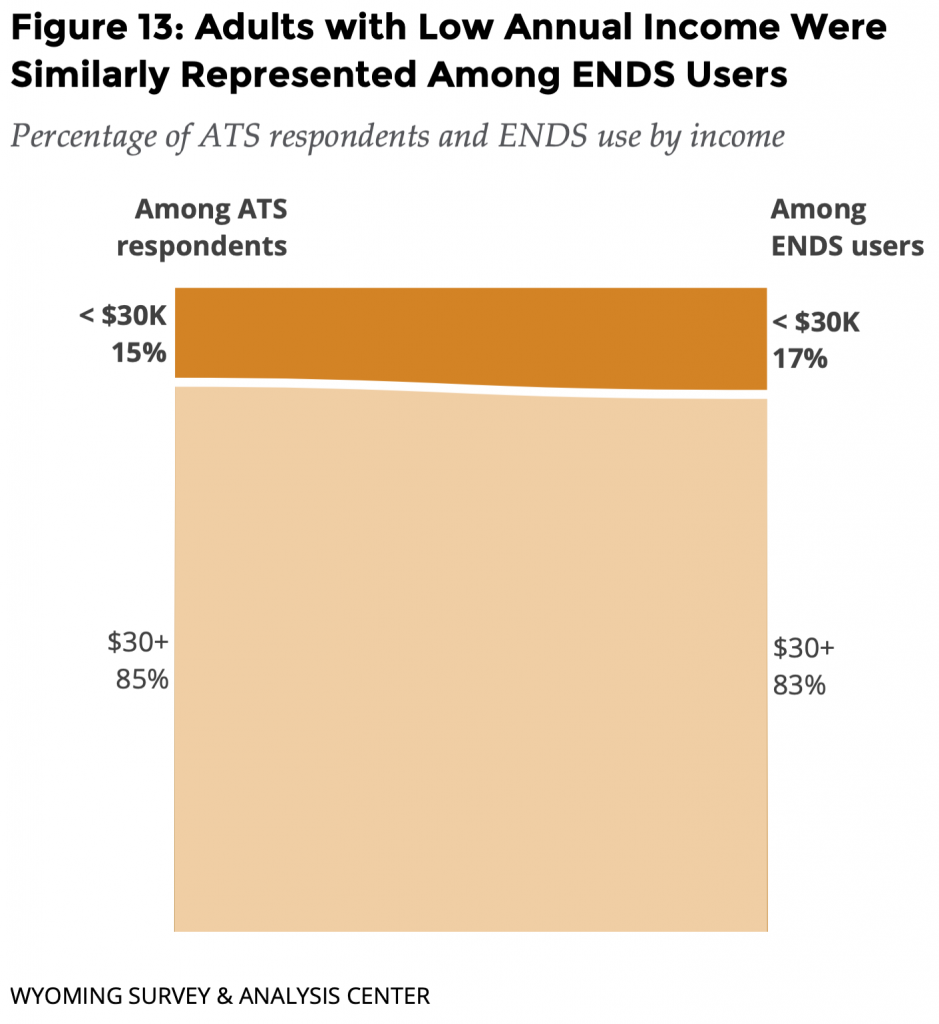 Lower-income neighborhoods have been targeted by tobacco industry marketing (Lee et al., 2015). With the tobacco industry’s focused strategies, adults with lower incomes have a disproportionately high rate of smoking (see the Goal Area 4: Identifying and Eliminating Tobacco-Related Disparities section for more information). More research is needed to understand if the ENDS industry is also using focused marketing toward people with lower incomes.
Lower-income neighborhoods have been targeted by tobacco industry marketing (Lee et al., 2015). With the tobacco industry’s focused strategies, adults with lower incomes have a disproportionately high rate of smoking (see the Goal Area 4: Identifying and Eliminating Tobacco-Related Disparities section for more information). More research is needed to understand if the ENDS industry is also using focused marketing toward people with lower incomes.
In Wyoming, income may not affect adults’ ENDS use. About the same percentage of adults with annual household incomes less than $30,000 used ENDS (7%).
Adults with low annual incomes were similarly represented among ENDS users. Fifteen percent of adults who responded to the survey had annual household incomes less than $30,000, and they made up 17% of ENDS users in the survey (Figure 13).
Although ENDS use does not differ for adults with lower incomes, saving money is a motivation for ENDS users. About 18% of adults who had tried vaping did so to save money, most likely compared to the cost of cigarettes (Figure 3). ENDS products and cigarettes are packaged and sold very differently. These differences make direct cost comparisons challenging for consumers. The 2019 ATS did not include any items about the cost of ENDS products.
Conclusions
Certain populations are more vulnerable to ENDS use. Three out of four of the TPCP’s priority populations (American Indians, young adults, and adults experiencing behavioral health conditions) have much higher ENDS use than those not in these priority groups. This may be because the ENDS industry has focused marketing toward young adults (Lee, 2020) and American Indians (Field, 2020). WYSAC’s literature review did not find conclusive evidence that the ENDS industry is also using targeted marketing toward people experiencing behavioral health conditions and lower incomes. Income does not appear related to adults’ ENDS use in Wyoming.
Using focused strategies to reach priority populations may help counter the ENDS industries’ targeted measures. Prevention messaging directed toward the TPCP priority populations is an important part of work to reduce disparities. Messaging for these new products could include educational material about potential harms and risks. Messaging may also include ensuring these populations are aware of cessation resources for quitting ENDS use, especially among young people.

